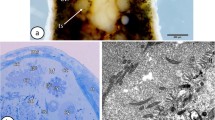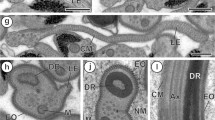Summary
Developing spermatids and mature spermatozoa from the isopod, Oniscus asellus and the amphipod, Orchestoidea sp. have been examined with the light microscope and the electron microscope and have been found to have similar morphologies. As spermiogenesis proceeds the nucleus migrates to one pole of the spermatid at which point an acrosome, contiguous rod, and cross-striated tail develop. The acrosomal vesicle elongates to a cone-shaped, mature acrosome lying at the apex of a cross-striated tail and nucleus which are situated at approximate forty-five degrees to each other. The cross-striated tail originates as an evagination of the spermatid plasma membrane near the acrosomal vesicle. The tail eventually grows to lengths of four to five hundred microns. The mature, tail-like appendage is cross-striated at major 750 to 800 Å, and minor 125 to 150 Å, periodicities. When observed in vitro, mature sperm of both species appear non-motile.
Possible homologies of this unusual spermatozoon with other types of spermatozoa are made and it is concluded that: 1) isopod and amphipod spermatozoa should be classified as non-flagellate; 2) the cross-striated tail, previously thought to be a flagellum, is a non-motile structure associated in development and possible function with the acrosome; and 3) the rodlike structure contiguous with the acrosome is similar to perforatoria described in some vertebrate sperm.
Similar content being viewed by others
References
Anderson, E., and H. W. Beams: The cytology of Trichomonas as revealed by the electron microscope. J. Morph. 104, 205–236 (1959).
Bishop, D. W., and H. Hoffman-Berling: Extracted mammalian sperm models. I. Preparation and reactivation with adenosine triphosphate. J. cell. comp. Physiol. 53, 445–466 (1959).
Blanchard, R. E., R. A. Lewin, and D. E. Philpott: Fine structure of sperm tails of isopods. Crustaceana 2, 16–20 (1961).
Fawcett, D. W., and K. R. Porter: A study of the fine structure of ciliated epithelia. J. Morph. 94, 221–282 (1954).
—: The cell, vol. II New York: Academic Press 1961.
Meyer, G. F.: Die parakristallinen Körper in den Spermienschwänzen von Drosophila. Z. Zellforsch. 62, 762–784 (1964).
Nagano, T.: Observations on the fine structure of the developing spermatid in the domestic chicken. J. Cell Biol. 14, 193–205 (1962).
Nath, V.: Cytology of spermatogenesis. Int. Rev. Cytol. 5, 395–453 (1965).
Pitelka, D. R., and C. N. Schooley: The fine structure of the flagellar apparatus in Trichonympha, J. Morph. 102, 199–246 (1958).
Prosser, C. L., and F. A. Brown: Comparative animal physiology, 2nd. ed. Philadelphia: W. B. Saunders Co. 1961.
Reger, J. F.: The fine structure of spermatids from the tick, Amblyomma dissimili. J. Ultrastruct. Res. 5, 584–599 (1961).
—: A fine structure study on spermiognenesis in the tick, Amblyomma dissimili, with special reference to the development of motile processes. J. Ultrastruct. Res. 7, 550–565 (1962).
—: Spermiogenesis in the tick, Amblyomma dissimili, as revealed by electron microscopy. J. Ultrastruct. Res. 8, 607–621 (1963).
—: A study on the fine structure of developing spermatozoa from the isopod, Asellus militaris. J. Microscopie 3, 559–572 (1964).
Robison, W. G.: Microtubules in relation to the motility of a sperm syncytium in an armored scale insect. J. Cell Biol. 29, 251–266 (1966).
Werner, G.: Untersuchungen über die Spermiogenese beim Sandläufer, Cicindela campestris, Linn. Z. Zellforsch. 66, 255–275 (1965).
Wilson, E. B.: The cell in development and heredity. New York: Macmillan Co. 1928.
Yasuzumi, G., and C. Oura: Spermatogenesis in animals as revealed by electron microscopy. XIV. The fine structure of the clear band and tubular structure in late stages of development of spermatids of the silkworm, Bombyx mori, Linn. Z. Zellforsch. 66, 182–196 (1965).
—, H. Tanaka, and O. Tezuka: Spermatogenesis in animals as revealed by electron microscopy. VIII. Relation between the nutritive cells and the developing spermatids in a pond snail, Cipangopaludina malleata. J. biophys. biochem. Cytol. 7, 499–504 (1960).
Yusa, A.: Fine structure of developing and mature trichocysts in Frontonia vesiculosa, J. Protozool. 12, 51–60 (1965).
Author information
Authors and Affiliations
Additional information
Supported by U.S.P.H.S. Grant No. NB-06285 and Training Grant No. 5-Tl-GM-202. — The author wishes to express his grateful appreciation for the technical assistance given by Miss Ann Barnett during the course of this investigation.
Rights and permissions
About this article
Cite this article
Reger, J.F. A comparative study on the fine structure of developing spermatozoa in the isopod, Oniscus asellus, and the amphipod, Orchestoidea sp. . Zeitschrift für Zellforschung 75, 579–590 (1966). https://doi.org/10.1007/BF00341515
Received:
Issue Date:
DOI: https://doi.org/10.1007/BF00341515




